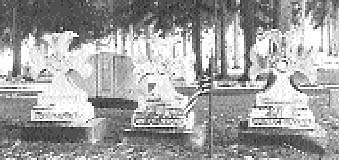The
Sons of Old Monroe
(continued)

Originally
buried on the Gettysburg field, O'Rorke was ultimately reinterred in Holy Sepulchre
Cemetery in Rochester. George Ryan, who succeeded him as regiment colonel, was
killed at Spotsylvania. In 1870, unit veterans brought Ryan's body by private
railroad car to Rochester, where he was buried next to O'Rorke.
Photo by Brian Bennett O'Rorke's regiment:
140th NYS volunteers
The 140th participated in all of Eastern
Theatre's major campaigns from December 1862 to the end of the war. After being
lightly engaged in the battles of Fredericksburg (Dec. 1862) and Chancellorsville
(May 1863) the regiment performed what one member called “the supreme event
in its existence” at Gettysburg.
Rushing to the defense of a vital
hill known as Little Round Top the 140th held the position, but at the cost of
over 100 casualties, including Col. O'Rorke. The 140th was among the first
units engaged in the opening contest of 1864, the battle of the Wilderness (May
5). The regiment lost over half its men in 20 minutes of combat and three days
later (May 8) lost another 65 men in the initial fighting at Spotsylvania Court
House. Down to under 200 men, the 140th managed to regain its number of
the remainder of 1864, despite participating in and losing men at such battles
as North Anna River, (May) Bethesda Church (June), Weldon Railroad (August), as
well as the siege of Petersburg, Virginia (June 1864-April 1865). On April
1, 1865 the 140th participated in the battle of Five Forks, Virginia, the contest
which finally drove the Confederate Army of Northern Virginia out of Richmond
and Petersburg. Eight days later the 140th was present at the surrender of Robert
E. Lee's army at Appomattox Court House, Virginia. The 140th was mustered
out of United States service June 3, 1865 with the names of over 20 major battles
emblazoned on its regimental banner. The paper strength of the regiment was about
600; of that number 200 had time remaining on their term of service and were transferred
to a different regiment. Another 100 were sick in hospitals or on detached service.
The remaining 300 were sent home. The regiment reached Rochester June 6, 1865.
Of the 30 returnees, 216 were original members of the unit. Total enrollment for
the regiment was 1,707. Deaths due to battle wounds were 149; disease, accidents,
imprisonment: 170 (77 of whom died while POWs). Total killed and wounded: 533.
Where the Boys of Old Monroe came from The 10 companies
of the 140th reflected the varied make-up of the city and county, as evidence
by the information below: Co. A: recruited from Brockport, Clarkson and
Sweden; almost all farmers. Co. B: almost all of German descent; 81 were
actually born in Germany. Co. C: mainly Irish from the city. Co. D: about
half from the city; remainder from the towns of Gates, Penfield, Brighton, Webster,
Chili, Henrietta and Parma. Co. E. Included men of nine different countries
of birth, including Australia. Co. F: exclusively from Rochester. Co.
G: from Rochester and the village of Churchville; included 14 natives of Switzerland.
Co. H: men of Rochester, Brockport and Fairport. Included a American Indian
from Canada. Co. I: The oldest company, averaging close to 30 years old,
including two drummer “boys” in their 40s. The most varied city/county
makeup, with 10 towns or villages represented. Co. K: Composed mainly of
Irishmen, including a handful of nurserymen and tobacconists. Building
an Army The base military unit in the Civil War was the regiment. Each
regiment consisted of 10 companies of approximately 100 men. The ranking officer
in the regiment was the colonel. Although on paper a regiment was to number
1,000, most regiments operated at a strength of 400-600. Regiments were combined
into larger units to form an army as follows: 4 regiments
= 1 brigade
3 brigades = 1 division
3 divisions = 1 corps
a grouping
of corps = 1 army At Gettysburg, for example, the 140th NY was part of
the Third Brigade, Second Division, Fifth Corps, Army of the Potomac.
4
Back | Home
According to WebCounter
you are the  person to answer the Clarion Call
person to answer the Clarion Call
©2008 Clarion Publications, Inc. All
Rights Reserved.
This site designed by Clarion Communications. | 
